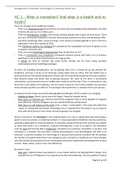Class notes
All lectures for the course MITCH, master MPA, VU Amsterdam
- Course
- Institution
All lectures of MITCH (Management of Innovative Technologies in Community based Healthcare) (AM_1181), of the master Management, Policy analysis and Entrepreneurship in Health and Life Sciences, at VU Amsterdam
[Show more]












